Task-Sensitive Efficient Feature Extraction Network for Oriented Object Detection in Remote Sensing Images
Abstract
1. Introduction
- (1)
- We systematically analyze the issue that existing detectors, when applied to remote sensing detection tasks, suffer from difficulty in extracting features precisely and efficiently, which limits further improvements in overall performance.
- (2)
- A special mixed fast convolution module is constructed by taking advantage of the feature redundancy in convolutional neural networks. Part of the traditional convolution operations are replaced with a simpler and cheaper way, effectively reducing the computational complexity and memory access.
- (3)
- A task-sensitive detection module is proposed, which employs adaptive dynamic convolution to align targets with arbitrary orientations, and further, utilizes a task-sensitive feature decoupling mechanism to effectively extract critical features required for classification and regression tasks from the aligned features, thereby enhancing detection performance.
- (4)
- A balanced loss function is proposed, which rebalances the gradients generated by different quality samples to make the process of network training more stable.
2. Related Works
2.1. Oriented Object Detection
2.2. Lightweight Network Design
3. Methodology
3.1. Special Mixed Fast Convolution
3.2. Task-Sensitive Detection Module
3.3. Balanced Loss
4. Experiments
4.1. Datasets
4.2. Experimental Evaluation Metrics
4.3. Implementation Details
4.4. Comparisons with Other Methods on Different Datasets
4.4.1. Results on DOTA
4.4.2. Results on HRSC2016
4.4.3. Results on UCAS-AOD
4.5. Feature Visualization
4.6. Ablation Studies
4.6.1. Evaluation on Different Components
4.6.2. Evaluation on Special Mixed Fast Convolution
4.6.3. Evaluation of Task-Sensitive Detection Module
4.6.4. Evaluation on Balanced Loss
5. Conclusions
Author Contributions
Funding
Data Availability Statement
Conflicts of Interest
References
- Huang, Z.; Li, W.; Xia, X.G.; Wang, H.; Jie, F.; Tao, R. LO-Det: Lightweight Oriented Object Detection in Remote Sensing Images. IEEE Trans. Geosci. Remote Sens. 2022, 60, 1–15. [Google Scholar] [CrossRef]
- Zhao, B.; Zhao, B.; Tang, L.; Han, Y.; Wang, W. Deep spatial-temporal joint feature representation for video object detection. Sensors 2018, 18, 774. [Google Scholar] [CrossRef]
- Haq, M.A.; Rahim Khan, M.A. DNNBoT: Deep neural network-based botnet detection and classification. Comput. Mater. Contin. 2022, 71, 1729–1750. [Google Scholar]
- Merugu, S.; Tiwari, A.; Sharma, S.K. Spatial–spectral image classification with edge preserving method. J. Indian Soc. Remote Sens. 2021, 49, 703–711. [Google Scholar] [CrossRef]
- Haq, M. DBoTPM: A Deep Neural Network-Based Botnet Prediction Model. Electronics 2023, 12, 1159. [Google Scholar] [CrossRef]
- Merugu, S.; Jain, K.; Mittal, A.; Raman, B. Sub-scene target detection and recognition using deep learning convolution neural networks. In Proceedings of the ICDSMLA 2019: Proceedings of the 1st International Conference on Data Science, Machine Learning and Applications; Springer: Berlin/Heidelberg, Germany, 2020; pp. 1082–1101. [Google Scholar]
- Liu, W.; Anguelov, D.; Erhan, D.; Szegedy, C.; Reed, S.; Fu, C.Y.; Berg, A.C. Ssd: Single shot multibox detector. In Proceedings of the Computer Vision–ECCV 2016: 14th European Conference, Amsterdam, The Netherlands, 11–14 October 2016; Proceedings, Part I 14. Springer: Berlin/Heidelberg, Germany, 2016; pp. 21–37. [Google Scholar]
- Redmon, J.; Divvala, S.; Girshick, R.; Farhadi, A. You only look once: Unified, real-time object detection. In Proceedings of the IEEE Conference on Computer Vision and Pattern Recognition, Las Vegas, NV, USA, 27–30 June 2016; pp. 779–788. [Google Scholar]
- Zhao, B.; Wang, Q.; Wu, Y.; Cao, Q.; Ran, Q. Target detection model distillation using feature transition and label registration for remote sensing imagery. IEEE J. Sel. Top. Appl. Earth Obs. Remote Sens. 2022, 15, 5416–5426. [Google Scholar] [CrossRef]
- Wang, K.; Liew, J.H.; Zou, Y.; Zhou, D.; Feng, J. Panet: Few-shot image semantic segmentation with prototype alignment. In Proceedings of the IEEE/CVF International Conference on Computer Vision, Seoul, Republic of Korea, 27 October–2 November 2019; pp. 9197–9206. [Google Scholar]
- Xu, Y.; Fu, M.; Wang, Q.; Wang, Y.; Chen, K.; Xia, G.S.; Bai, X. Gliding vertex on the horizontal bounding box for multi-oriented object detection. IEEE Trans. Pattern Anal. Mach. Intell. 2020, 43, 1452–1459. [Google Scholar] [CrossRef]
- Wang, J.; Yang, W.; Li, H.C.; Zhang, H.; Xia, G.S. Learning center probability map for detecting objects in aerial images. IEEE Trans. Geosci. Remote Sens. 2020, 59, 4307–4323. [Google Scholar] [CrossRef]
- Yang, X.; Hou, L.; Zhou, Y.; Wang, W.; Yan, J. Dense label encoding for boundary discontinuity free rotation detection. In Proceedings of the IEEE/CVF Conference on Computer Vision and Pattern Recognition, Nashville, TN, USA, 20–25 June 2021; pp. 15819–15829. [Google Scholar]
- Yang, X.; Yan, J.; Liao, W.; Yang, X.; Tang, J.; He, T. Scrdet++: Detecting small, cluttered and rotated objects via instance-level feature denoising and rotation loss smoothing. IEEE Trans. Pattern Anal. Mach. Intell. 2022, 45, 2384–2399. [Google Scholar] [CrossRef]
- Qiu, H.; Li, H.; Wu, Q.; Meng, F.; Ngan, K.N.; Shi, H. A2RMNet: Adaptively aspect ratio multi-scale network for object detection in remote sensing images. Remote Sens. 2019, 11, 1594. [Google Scholar] [CrossRef]
- Ren, S.; He, K.; Girshick, R.; Sun, J. Faster r-cnn: Towards real-time object detection with region proposal networks. Adv. Neural Inf. Process. Syst. 2015, 28. [Google Scholar] [CrossRef]
- Cai, Z.; Vasconcelos, N. Cascade r-cnn: Delving into high quality object detection. In Proceedings of the IEEE Conference on Computer Vision and Pattern Recognition, Salt Lake City, UT, USA, 18–23 June 2018; pp. 6154–6162. [Google Scholar]
- Jiang, Y.; Zhu, X.; Wang, X.; Yang, S.; Li, W.; Wang, H.; Fu, P.; Luo, Z. R2CNN: Rotational region CNN for orientation robust scene text detection. arXiv 2017, arXiv:1706.09579. [Google Scholar]
- Ding, J.; Xue, N.; Long, Y.; Xia, G.S.; Lu, Q. Learning RoI transformer for oriented object detection in aerial images. In Proceedings of the IEEE/CVF Conference on Computer Vision and Pattern Recognition, Long Beach, CA, USA, 15–20 June 2019; pp. 2849–2858. [Google Scholar]
- Iandola, F.N.; Han, S.; Moskewicz, M.W.; Ashraf, K.; Dally, W.J.; Keutzer, K. SqueezeNet: AlexNet-level accuracy with 50x fewer parameters and <0.5 MB model size. arXiv 2016, arXiv:1602.07360. [Google Scholar]
- Szegedy, C.; Vanhoucke, V.; Ioffe, S.; Shlens, J.; Wojna, Z. Rethinking the inception architecture for computer vision. In Proceedings of the IEEE Conference on Computer Vision and Pattern Recognition, Las Vegas, NV, USA, 26 June–1 July 2016; pp. 2818–2826. [Google Scholar]
- Tan, M.; Le, Q. Efficientnet: Rethinking model scaling for convolutional neural networks. In Proceedings of the International Conference on Machine Learning, PMLR, Long Beach, CA, USA, 9–15 June 2019; pp. 6105–6114. [Google Scholar]
- Han, S.; Pool, J.; Tran, J.; Dally, W. Learning both weights and connections for efficient neural network. Adv. Neural Inf. Process. Syst. 2015, 28. [Google Scholar]
- Liu, Z.; Li, J.; Shen, Z.; Huang, G.; Yan, S.; Zhang, C. Learning efficient convolutional networks through network slimming. In Proceedings of the IEEE International Conference on Computer Vision, Venice, Italy, 22–29 October 2017; pp. 2736–2744. [Google Scholar]
- Wu, Y.; Chen, Y.; Yuan, L.; Liu, Z.; Wang, L.; Li, H.; Fu, Y. Rethinking classification and localization for object detection. In Proceedings of the IEEE/CVF Conference on Computer Vision and Pattern Recognition, Seattle, WA, USA, 13–19 June 2020; pp. 10186–10195. [Google Scholar]
- Jiang, B.; Luo, R.; Mao, J.; Xiao, T.; Jiang, Y. Acquisition of localization confidence for accurate object detection. In Proceedings of the European Conference on Computer Vision (ECCV), Munich, Germany, 8–14 September 2018; pp. 784–799. [Google Scholar]
- Ming, Q.; Miao, L.; Zhou, Z.; Dong, Y. CFC-Net: A critical feature capturing network for arbitrary-oriented object detection in remote-sensing images. IEEE Trans. Geosci. Remote Sens. 2021, 60, 1–14. [Google Scholar] [CrossRef]
- Liao, M.; Zhu, Z.; Shi, B.; Xia, G.s.; Bai, X. Rotation-sensitive regression for oriented scene text detection. In Proceedings of the IEEE Conference on Computer Vision and Pattern Recognition, Salt Lake City, UT, USA, 18–23 June 2018; pp. 5909–5918. [Google Scholar]
- Fu, K.; Chang, Z.; Zhang, Y.; Xu, G.; Zhang, K.; Sun, X. Rotation-aware and multi-scale convolutional neural network for object detection in remote sensing images. ISPRS J. Photogramm. Remote Sens. 2020, 161, 294–308. [Google Scholar] [CrossRef]
- Cheng, G.; Zhou, P.; Han, J. Learning rotation-invariant convolutional neural networks for object detection in VHR optical remote sensing images. IEEE Trans. Geosci. Remote Sens. 2016, 54, 7405–7415. [Google Scholar] [CrossRef]
- Pan, X.; Ren, Y.; Sheng, K.; Dong, W.; Yuan, H.; Guo, X.; Ma, C.; Xu, C. Dynamic refinement network for oriented and densely packed object detection. In Proceedings of the IEEE/CVF Conference on Computer Vision and Pattern Recognition, Seattle, WA, USA, 13–19 June 2020; pp. 11207–11216. [Google Scholar]
- Zhang, Z.; Guo, W.; Zhu, S.; Yu, W. Toward arbitrary-oriented ship detection with rotated region proposal and discrimination networks. IEEE Geosci. Remote Sens. Lett. 2018, 15, 1745–1749. [Google Scholar] [CrossRef]
- Han, J.; Ding, J.; Xue, N.; Xia, G.S. Redet: A rotation-equivariant detector for aerial object detection. In Proceedings of the IEEE/CVF Conference on Computer Vision and Pattern Recognition, Nashville, TN, USA, 20–25 June 2021; pp. 2786–2795. [Google Scholar]
- Liu, L.; Pan, Z.; Lei, B. Learning a rotation invariant detector with rotatable bounding box. arXiv 2017, arXiv:1711.09405. [Google Scholar]
- Wang, J.; Chen, K.; Yang, S.; Loy, C.C.; Lin, D. Region proposal by guided anchoring. In Proceedings of the IEEE/CVF Conference on Computer Vision and Pattern Recognition, Long Beach, CA, USA, 15–20 June 2019; pp. 2965–2974. [Google Scholar]
- Hu, J.; Lin, P.; Zhang, H.; Lan, Z.; Chen, W.; Xie, K.; Chen, S.; Wang, H.; Chang, S. A Dynamic Pruning Method on Multiple Sparse Structures in Deep Neural Networks. IEEE Access 2023, 11, 38448–38457. [Google Scholar] [CrossRef]
- Lee, J.R.; Moon, Y.H. An Empirical Study on Channel Pruning through Residual Connections. In Proceedings of the 2021 International Conference on Information and Communication Technology Convergence (ICTC), Jeju Island, Republic of Korea, 20–22 October 2021; pp. 1380–1382. [Google Scholar]
- Jacob, B.; Kligys, S.; Chen, B.; Zhu, M.; Tang, M.; Howard, A.; Adam, H.; Kalenichenko, D. Quantization and training of neural networks for efficient integer-arithmetic-only inference. In Proceedings of the IEEE Conference on Computer Vision and Pattern Recognition, Salt Lake City, UT, USA, 18–23 June 2018; pp. 2704–2713. [Google Scholar]
- Howard, A.G.; Zhu, M.; Chen, B.; Kalenichenko, D.; Wang, W.; Weyand, T.; Andreetto, M.; Adam, H. Mobilenets: Efficient convolutional neural networks for mobile vision applications. arXiv 2017, arXiv:1704.04861. [Google Scholar]
- Sandler, M.; Howard, A.; Zhu, M.; Zhmoginov, A.; Chen, L.C. Mobilenetv2: Inverted residuals and linear bottlenecks. In Proceedings of the IEEE Conference on Computer Vision and Pattern Recognition, Salt Lake City, UT, USA, 18–23 June 2018; pp. 4510–4520. [Google Scholar]
- Howard, A.; Sandler, M.; Chu, G.; Chen, L.C.; Chen, B.; Tan, M.; Wang, W.; Zhu, Y.; Pang, R.; Vasudevan, V.; et al. Searching for mobilenetv3. In Proceedings of the IEEE/CVF International Conference on Computer Vision, Seoul, Republic of Korea, 27 October–2 November 2019; pp. 1314–1324. [Google Scholar]
- Zhang, X.; Zhou, X.; Lin, M.; Sun, J. Shufflenet: An extremely efficient convolutional neural network for mobile devices. In Proceedings of the IEEE Conference on Computer Vision and Pattern Recognition, Salt Lake City, UT, USA, 18–23 June 2018; pp. 6848–6856. [Google Scholar]
- Ma, N.; Zhang, X.; Zheng, H.T.; Sun, J. Shufflenet v2: Practical guidelines for efficient cnn architecture design. In Proceedings of the European Conference on Computer Vision (ECCV), Munich, Germany, 8–14 September 2018; pp. 116–131. [Google Scholar]
- Wang, N.; Li, B.; Wei, X.; Wang, Y.; Yan, H. Ship detection in spaceborne infrared image based on lightweight CNN and multisource feature cascade decision. IEEE Trans. Geosci. Remote Sens. 2020, 59, 4324–4339. [Google Scholar] [CrossRef]
- Mehta, S.; Rastegari, M. Mobilevit: Light-weight, general-purpose, and mobile-friendly vision transformer. arXiv 2021, arXiv:2110.02178. [Google Scholar]
- Chen, S.; Xie, E.; Ge, C.; Chen, R.; Liang, D.; Luo, P. CycleMLP: A MLP-Like Architecture for Dense Visual Predictions. IEEE Trans. Pattern Anal. Mach. Intell. 2023, 45, 14284–14300. [Google Scholar] [CrossRef] [PubMed]
- Yang, B.; Bender, G.; Le, Q.V.; Ngiam, J. Condconv: Conditionally parameterized convolutions for efficient inference. Adv. Neural Inf. Process. Syst. 2019, 32. [Google Scholar]
- Zhou, Y.; Ye, Q.; Qiu, Q.; Jiao, J. Oriented response networks. In Proceedings of the IEEE Conference on Computer Vision and Pattern Recognition, Honolulu, HI, USA, 21–26 July 2017; pp. 519–528. [Google Scholar]
- Girshick, R. Fast r-cnn. In Proceedings of the IEEE International Conference on Computer Vision, Santiago, Chile, 7–13 December 2015; pp. 1440–1448. [Google Scholar]
- Zhu, H.; Chen, X.; Dai, W.; Fu, K.; Ye, Q.; Jiao, J. Orientation robust object detection in aerial images using deep convolutional neural network. In Proceedings of the 2015 IEEE International Conference on Image Processing (ICIP), Quebec City, QC, Canada, 27–30 September 2015; pp. 3735–3739. [Google Scholar]
- Liu, Z.; Yuan, L.; Weng, L.; Yang, Y. A high resolution optical satellite image dataset for ship recognition and some new baselines. In Proceedings of the International Conference on Pattern Recognition Applications and Methods, SciTePress, Porto, Portugal, 24–26 February 2017; Volume 2, pp. 324–331. [Google Scholar]
- Xia, G.S.; Bai, X.; Ding, J.; Zhu, Z.; Belongie, S.; Luo, J.; Datcu, M.; Pelillo, M.; Zhang, L. DOTA: A large-scale dataset for object detection in aerial images. In Proceedings of the IEEE Conference on Computer Vision and Pattern Recognition, Salt Lake City, UT, USA, 18–23 June 2018; pp. 3974–3983. [Google Scholar]
- Yang, X.; Yang, J.; Yan, J.; Zhang, Y.; Zhang, T.; Guo, Z.; Sun, X.; Fu, K. Scrdet: Towards more robust detection for small, cluttered and rotated objects. In Proceedings of the IEEE/CVF International Conference on Computer Vision, Seoul, Republic of Korea, 27 October–2 November 2019; pp. 8232–8241. [Google Scholar]
- Ma, J.; Shao, W.; Ye, H.; Wang, L.; Wang, H.; Zheng, Y.; Xue, X. Arbitrary-oriented scene text detection via rotation proposals. IEEE Trans. Multimed. 2018, 20, 3111–3122. [Google Scholar] [CrossRef]
- Yang, X.; Yan, J. On the arbitrary-oriented object detection: Classification based approaches revisited. Int. J. Comput. Vis. 2022, 130, 1340–1365. [Google Scholar] [CrossRef]
- Yang, X.; Yan, J.; Feng, Z.; He, T. R3det: Refined single-stage detector with feature refinement for rotating object. In Proceedings of the AAAI Conference on Artificial Intelligence, Virtually, 2–9 February 2021; Volume 35, pp. 3163–3171. [Google Scholar]
- Qian, W.; Yang, X.; Peng, S.; Yan, J.; Guo, Y. Learning modulated loss for rotated object detection. In Proceedings of the AAAI Conference on Artificial Intelligence, Virtually, 2–9 February 2021; Volume 35, pp. 2458–2466. [Google Scholar]
- Zhang, G.; Lu, S.; Zhang, W. CAD-Net: A context-aware detection network for objects in remote sensing imagery. IEEE Trans. Geosci. Remote Sens. 2019, 57, 10015–10024. [Google Scholar] [CrossRef]
- Ming, Q.; Miao, L.; Zhou, Z.; Yang, X.; Dong, Y. Optimization for arbitrary-oriented object detection via representation invariance loss. IEEE Geosci. Remote Sens. Lett. 2021, 19, 1–5. [Google Scholar] [CrossRef]
- Ren, Z.; Tang, Y.; He, Z.; Tian, L.; Yang, Y.; Zhang, W. Ship detection in high-resolution optical remote sensing images aided by saliency information. IEEE Trans. Geosci. Remote Sens. 2022, 60, 1–16. [Google Scholar] [CrossRef]
- Han, J.; Ding, J.; Li, J.; Xia, G.S. Align deep features for oriented object detection. IEEE Trans. Geosci. Remote Sens. 2021, 60, 1–11. [Google Scholar] [CrossRef]
- Shu, Z.; Hu, X.; Sun, J. Center-point-guided proposal generation for detection of small and dense buildings in aerial imagery. IEEE Geosci. Remote Sens. Lett. 2018, 15, 1100–1104. [Google Scholar] [CrossRef]
- Lin, T.Y.; Goyal, P.; Girshick, R.; He, K.; Dollár, P. Focal loss for dense object detection. In Proceedings of the IEEE International Conference on Computer Vision, Venice, Italy, 22–29 October 2017; pp. 2980–2988. [Google Scholar]
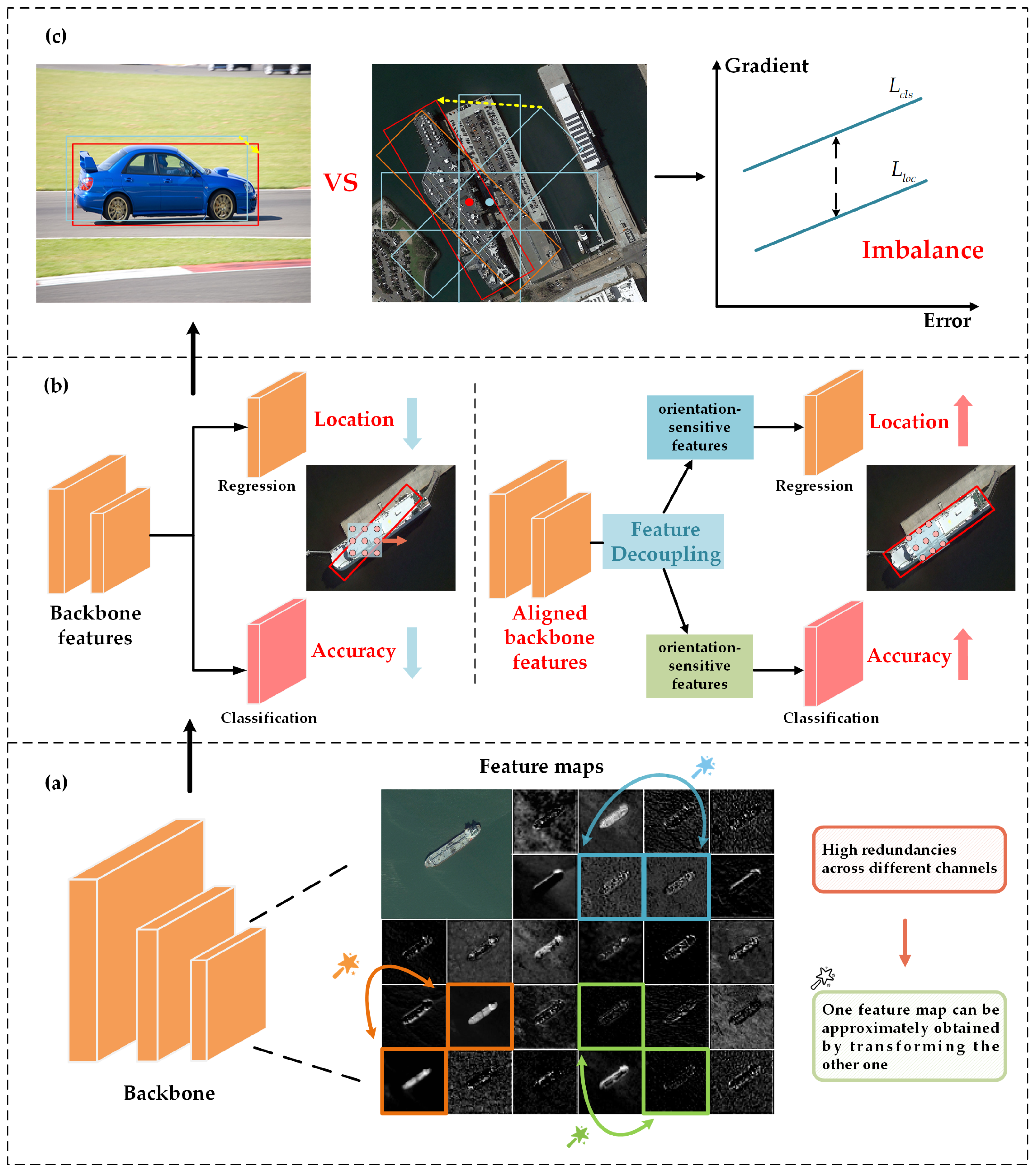
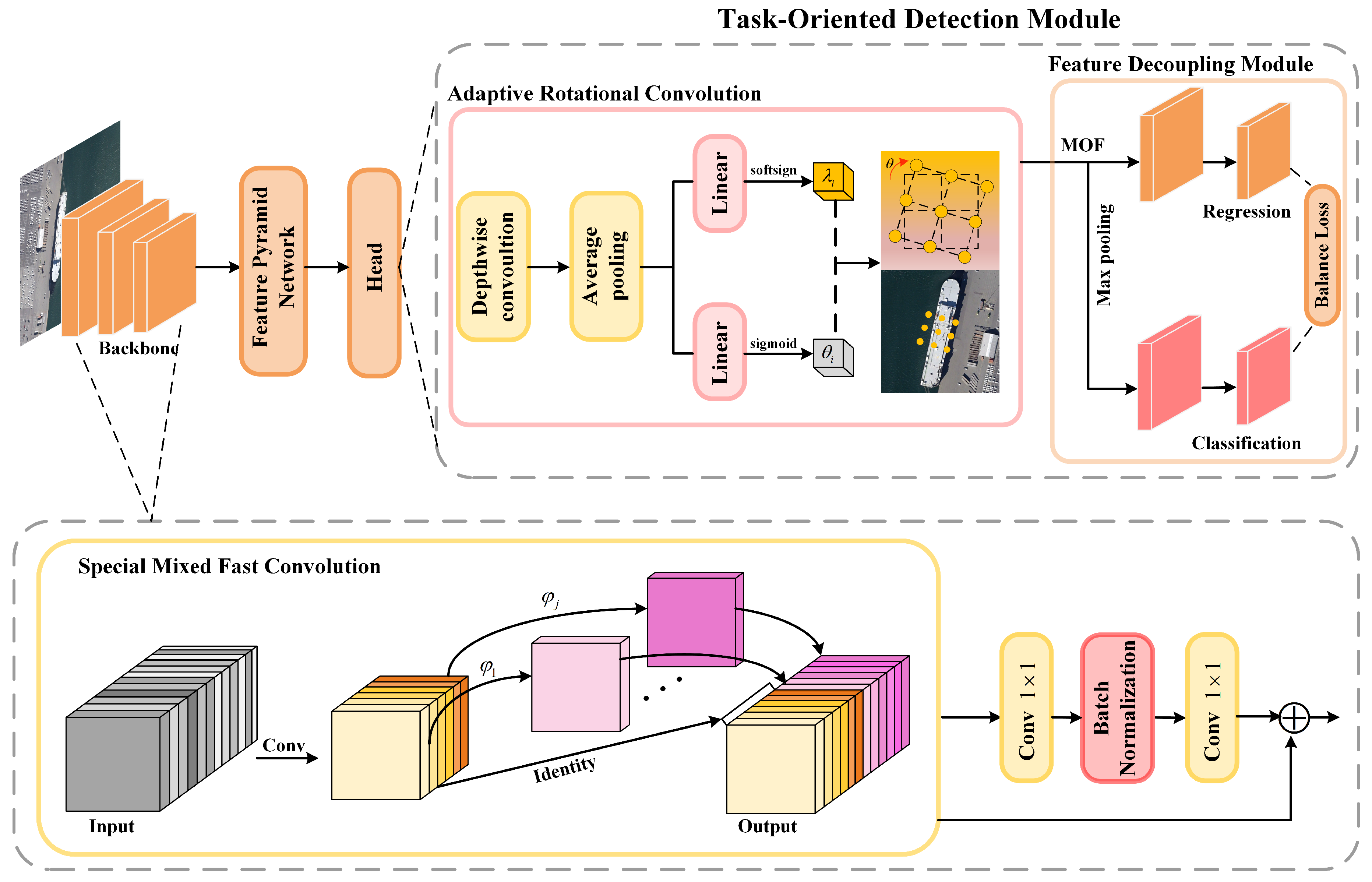


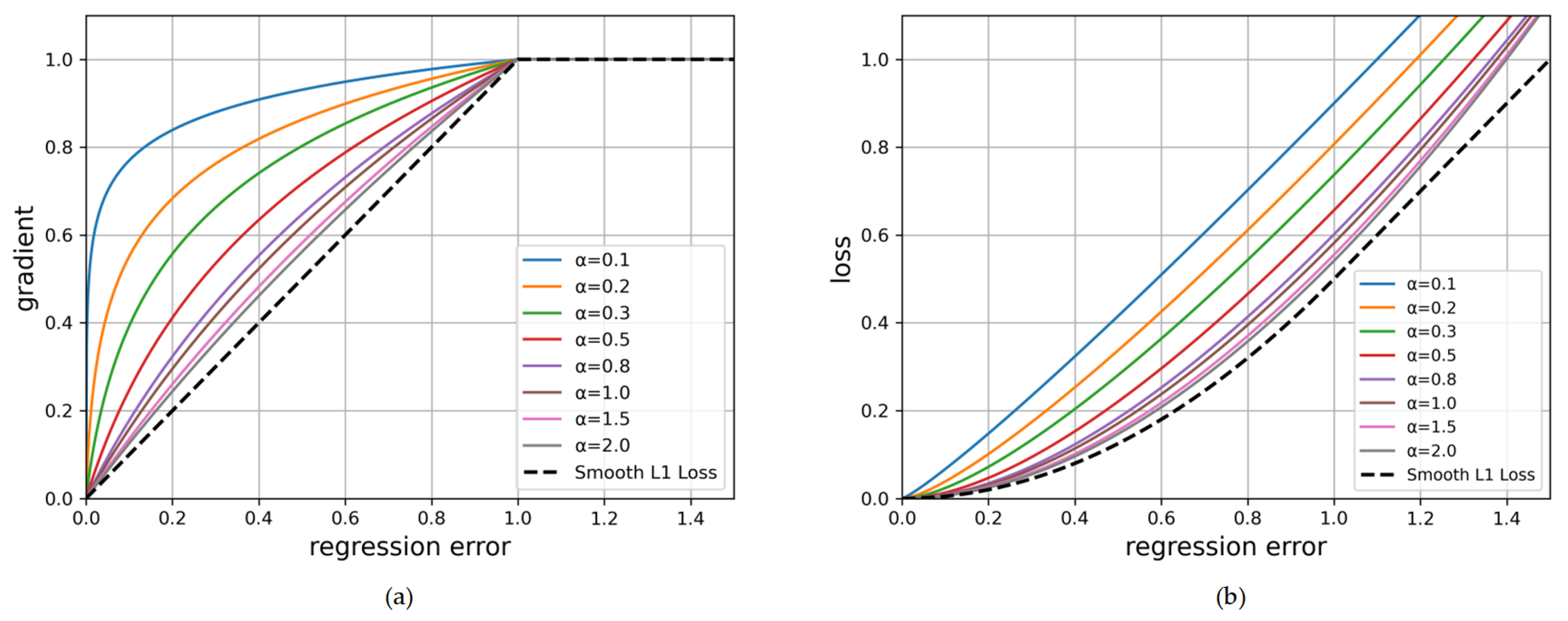

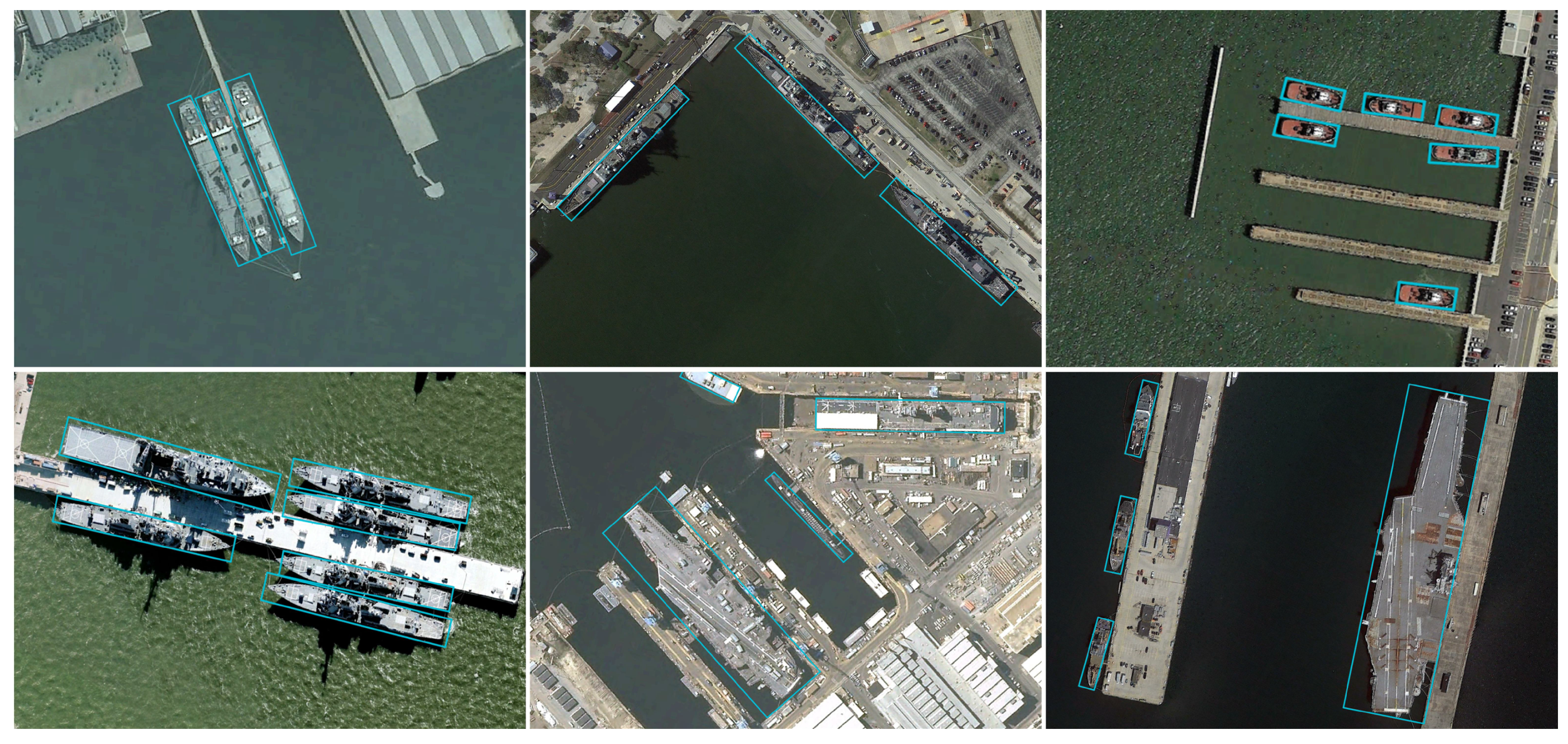
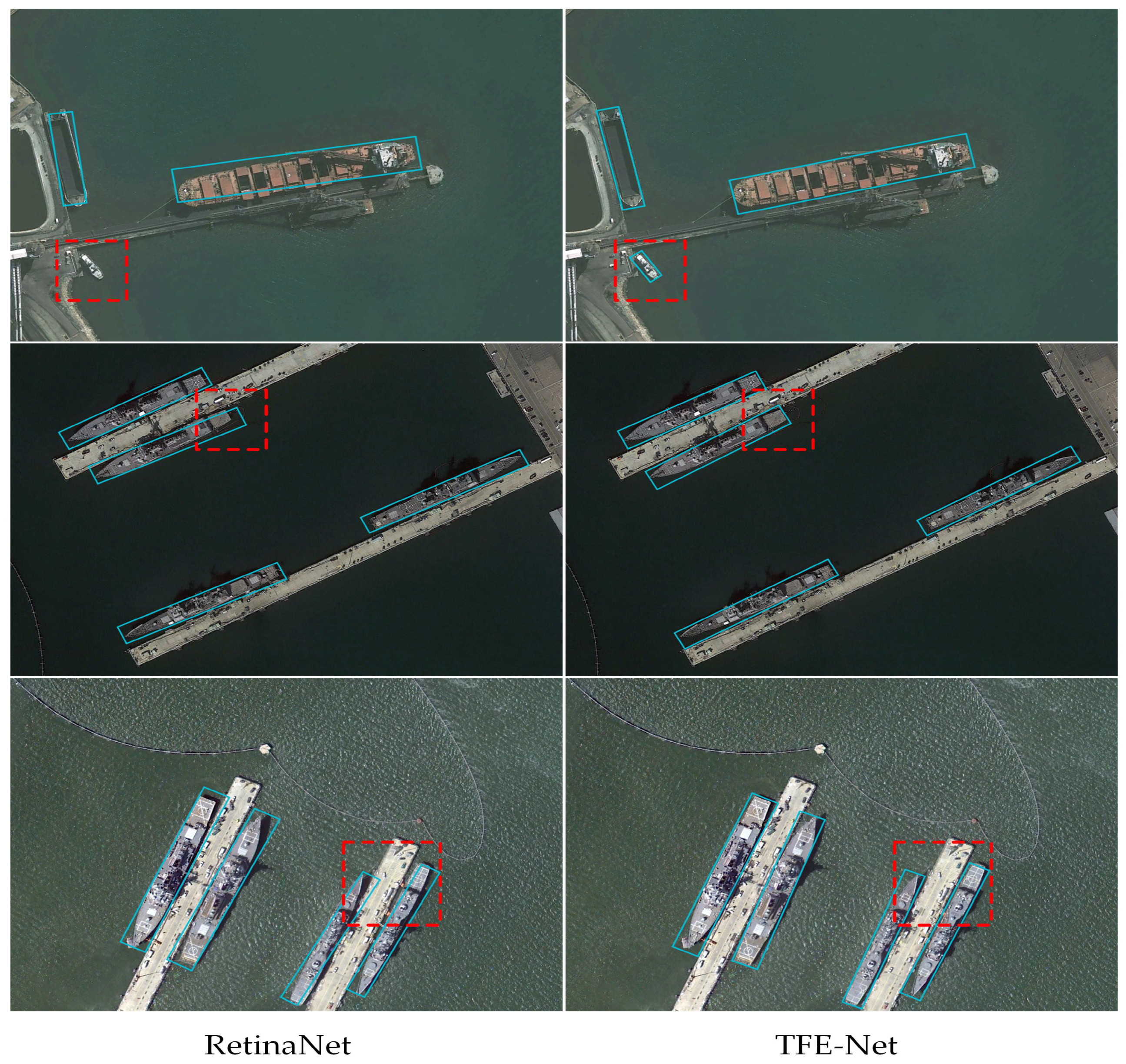


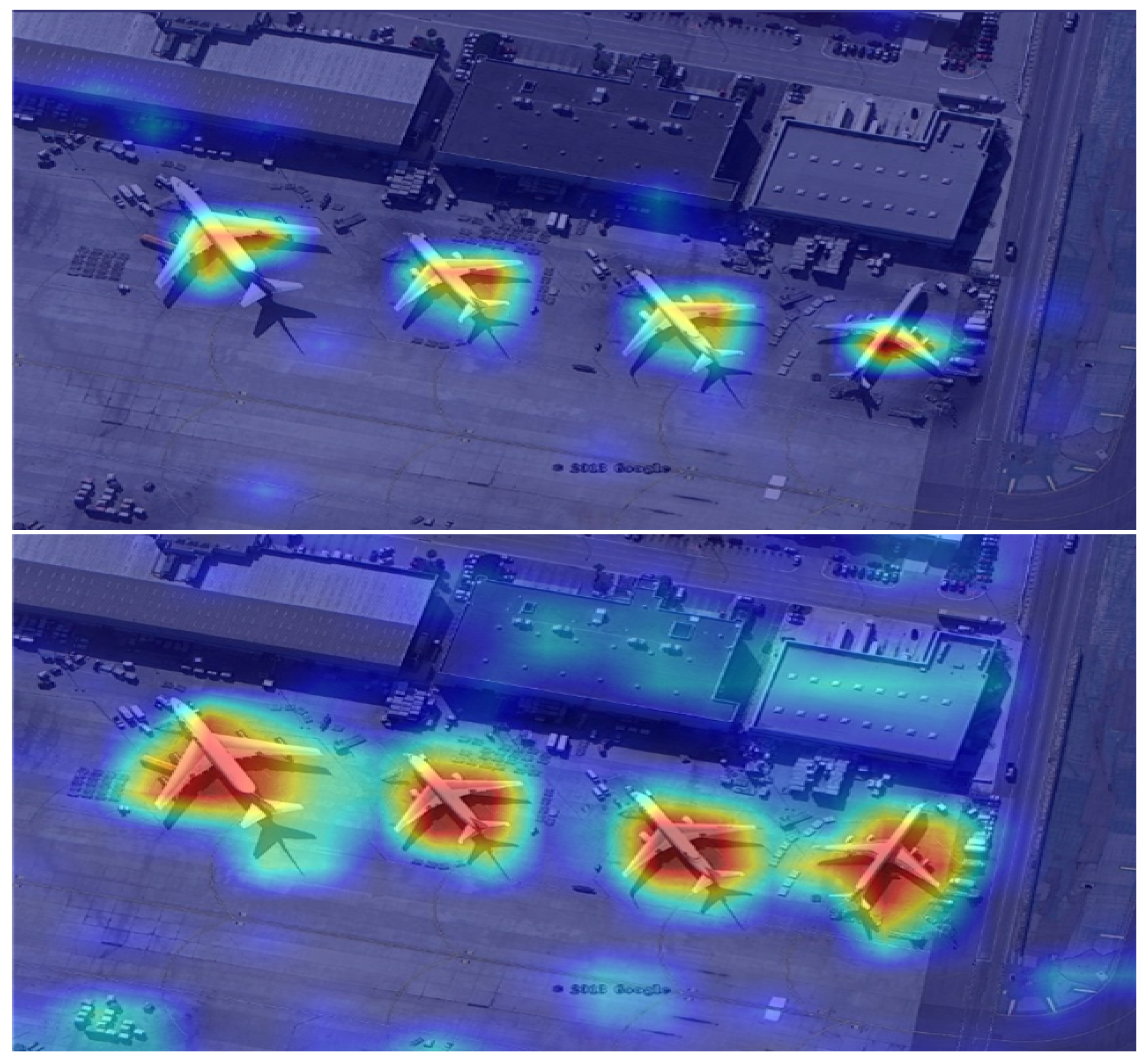
| Method | PL | SH | ST | BD | TC | BC | GTF | HA | BR | LV | SV | HC | RA | SBF | SP | mAP |
|---|---|---|---|---|---|---|---|---|---|---|---|---|---|---|---|---|
| SCRDet [53] | 89.98 | 72.41 | 86.86 | 80.65 | 90.85 | 87.94 | 68.36 | 66.25 | 52.09 | 60.32 | 68.36 | 65.21 | 66.68 | 65.02 | 68.24 | 72.67 |
| SCRDet++ [14] | 90.01 | 78.83 | 85.10 | 82.32 | 90.86 | 86.32 | 68.62 | 77.69 | 61.94 | 81.17 | 69.92 | 64.25 | 61.12 | 65.10 | 80.68 | 76.24 |
| RRPN [54] | 88.52 | 57.25 | 67.38 | 71.20 | 90.81 | 72.84 | 59.30 | 53.08 | 31.66 | 56.19 | 51.85 | 53.85 | 52.84 | 56.69 | 51.94 | 61.01 |
| CSL [55] | 90.12 | 77.62 | 86.69 | 85.53 | 90.84 | 86.15 | 75.31 | 73.83 | 54.64 | 73.51 | 70.44 | 68.93 | 68.04 | 69.60 | 71.10 | 76.17 |
| FR-O [16] | 79.42 | 37.16 | 59.28 | 77.13 | 89.41 | 69.64 | 64.05 | 47.89 | 17.70 | 38.02 | 35.30 | 46.30 | 52.91 | 50.30 | 47.40 | 54.13 |
| R3Det [56] | 89.54 | 77.54 | 83.54 | 81.99 | 90.80 | 81.39 | 62.52 | 65.44 | 48.46 | 74.29 | 70.48 | 60.05 | 89.82 | 61.97 | 67.46 | 71.69 |
| RoI-Trans [19] | 88.64 | 83.59 | 81.46 | 78.52 | 90.74 | 77.27 | 75.92 | 62.83 | 43.44 | 73.68 | 68.81 | 47.67 | 53.54 | 58.39 | 58.93 | 69.56 |
| RSDet [57] | 89.80 | 70.20 | 83.40 | 82.90 | 90.50 | 85.60 | 65.20 | 65.60 | 48.60 | 70.10 | 69.50 | 68.00 | 63.90 | 62.50 | 67.20 | 72.20 |
| CADNet [58] | 87.80 | 76.60 | 73.30 | 82.40 | 90.90 | 79.20 | 73.50 | 62.00 | 49.40 | 63.50 | 71.10 | 62.20 | 60.90 | 48.40 | 67.00 | 69.90 |
| RIDet-O [59] | 88.94 | 88.18 | 83.61 | 78.45 | 90.55 | 81.33 | 72.63 | 73.09 | 46.87 | 80.68 | 77.63 | 56.87 | 63.72 | 64.85 | 73.13 | 74.70 |
| Gliding Vertex [11] | 89.64 | 86.82 | 86.81 | 85.00 | 90.74 | 79.02 | 77.34 | 72.94 | 52.26 | 73.14 | 73.01 | 57.32 | 70.91 | 59.55 | 70.86 | 75.02 |
| R2CNN [18] | 80.94 | 55.81 | 72.39 | 65.67 | 90.67 | 66.92 | 67.44 | 55.14 | 35.34 | 50.91 | 59.92 | 48.22 | 52.23 | 55.06 | 53.35 | 60.67 |
| TFE-Net (ours) | 90.32 | 88.67 | 74.90 | 83.01 | 90.93 | 85.58 | 78.85 | 78.61 | 62.33 | 80.25 | 72.36 | 66.54 | 85.84 | 67.70 | 82.91 | 79.25 |
| Explanation of each category: | ||||||||||||||||
| Full Name | plane | baseball diamond | bridge | ground track field | small vehicle | large vehicle | ship | tennis court | basket- ball court | storage tank | soccer- ball field | round- about | harbor | swim- ming pool | heli- copter | – |
| Method | Backbone | Size | mAP |
|---|---|---|---|
| RRPN [54] | ResNet101 | 800 × 800 | 79.1 |
| R2CNN [18] | ResNet101 | 800 × 800 | 73.1 |
| RoI-Trans [19] | ResNet101 | 512 × 800 | 86.2 |
| RRD [28] | VGG16 | 384 × 384 | 84.3 |
| Gliding Vertex [11] | ResNet101 | 512 × 800 | 88.2 |
| SDet [60] | ResNet101 | 800 × 800 | 89.2 |
| R3Det [56] | ResNet101 | 800 × 800 | 89.3 |
| TFE-Net (ours) | ResNet101 | 800 × 800 | 90.2 |
| Method | Car | Airplane | mAP |
|---|---|---|---|
| R2PN [32] | 76.74 | 88.66 | 78.63 |
| RoI-Trans [19] | 88.02 | 90.02 | 89.02 |
| S2ANet [61] | 89.56 | 90.42 | 89.99 |
| DRBox [34] | 85.00 | 94.90 | 89.95 |
| RIDet-O [62] | 88.88 | 90.35 | 89.62 |
| R-RetinaNet [63] | 84.65 | 85.46 | 78.19 |
| TFE-Net (ours) | 87.04 | 94.68 | 90.86 |
| With SMFC? | With TDM? | With BLoss | FLOPs (G) | mAP |
|---|---|---|---|---|
| ✗ | ✗ | ✗ | 137.8 | 84.2% |
| ✓ | ✗ | ✗ | 71.2 | 85.5% |
| ✗ | ✓ | ✗ | 158.0 | 89.1% |
| ✓ | ✓ | ✗ | 109.6 | 88.4% |
| ✗ | ✓ | ✓ | 163.5 | 91.3% |
| ✓ | ✓ | ✓ | 97.6 | 90.9% |
| With SMFC? | With TDM? | With BLoss | FLOPs (G) | mAP |
|---|---|---|---|---|
| ✗ | ✗ | ✗ | 137.6 | 82.0% |
| ✓ | ✗ | ✗ | 71.2 | 83.1% |
| ✗ | ✓ | ✗ | 157.8 | 89.6% |
| ✓ | ✓ | ✗ | 109.5 | 89.0% |
| ✗ | ✓ | ✓ | 163.2 | 90.8% |
| ✓ | ✓ | ✓ | 97.3 | 90.2% |
| l | FLOPs (G) | mAP |
|---|---|---|
| 1 | 96.8 | 88.4% |
| 3 | 97.3 | 90.2% |
| 5 | 97.7 | 89.6% |
| 7 | 98.2 | 88.0% |
| q | FLOPs (G) | mAP |
|---|---|---|
| 2 | 114.3 | 91.2% |
| 3 | 97.3 | 90.2% |
| 4 | 88.5 | 85.4% |
| 5 | 78.9 | 81.2% |
| 6 | 66.0 | 77.9% |
| With ADC? | With TFDM? | mAP |
|---|---|---|
| ✗ | ✗ | 84.5% |
| ✓ | ✗ | 86.4% |
| ✗ | ✓ | 87.8% |
| ✓ | ✓ | 90.2% |
| Settings | mAP |
|---|---|
| L1 loss | 89.1% |
| 89.5% | |
| 89.7% | |
| 90.2% | |
| 89.8% |
Disclaimer/Publisher’s Note: The statements, opinions and data contained in all publications are solely those of the individual author(s) and contributor(s) and not of MDPI and/or the editor(s). MDPI and/or the editor(s) disclaim responsibility for any injury to people or property resulting from any ideas, methods, instructions or products referred to in the content. |
© 2024 by the authors. Licensee MDPI, Basel, Switzerland. This article is an open access article distributed under the terms and conditions of the Creative Commons Attribution (CC BY) license (https://creativecommons.org/licenses/by/4.0/).
Share and Cite
Liu, Z.; He, G.; Dong, L.; Jing, D.; Zhang, H. Task-Sensitive Efficient Feature Extraction Network for Oriented Object Detection in Remote Sensing Images. Remote Sens. 2024, 16, 2271. https://doi.org/10.3390/rs16132271
Liu Z, He G, Dong L, Jing D, Zhang H. Task-Sensitive Efficient Feature Extraction Network for Oriented Object Detection in Remote Sensing Images. Remote Sensing. 2024; 16(13):2271. https://doi.org/10.3390/rs16132271
Chicago/Turabian StyleLiu, Zhe, Guiqing He, Liheng Dong, Donglin Jing, and Haixi Zhang. 2024. "Task-Sensitive Efficient Feature Extraction Network for Oriented Object Detection in Remote Sensing Images" Remote Sensing 16, no. 13: 2271. https://doi.org/10.3390/rs16132271
APA StyleLiu, Z., He, G., Dong, L., Jing, D., & Zhang, H. (2024). Task-Sensitive Efficient Feature Extraction Network for Oriented Object Detection in Remote Sensing Images. Remote Sensing, 16(13), 2271. https://doi.org/10.3390/rs16132271









